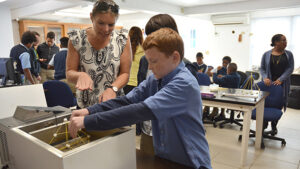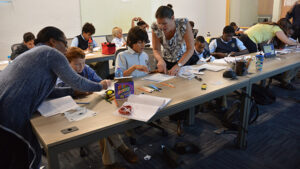New BIOS Partnership Enhances School’s Science Curriculum

BIOS science educator Kaitlin Baird leads Chatmore students in an exploration of design and engineering principles by constructing 3-D models and testing them on an “earthquake” shake-table.
BIOS’s Ocean Academy program has a new partner in delivering hands-on science education and learning opportunities to Bermuda’s students: The Chatmore Preparatory School.
Angela Fubler, founder and director of the all-boys private school, credits an early conversation she had with Mark Guishard, BIOS director of corporate and community relations, with laying the groundwork for this new collaboration.
“The timing was perfect and the connection between BIOS staff and our team at Chatmore was instant,” Fubler said of the meeting.
Along with Andrea Cann, Chatmore’s assistant director, Fubler shared her vision with BIOS education staff of celebrating local expertise, engaging the community as an educational resource, and aligning learning experiences with students’ natural interests and talent.
Beginning in mid-November, BIOS educators and scientists began providing experiential learning opportunities for Chatmore’s twelve S1 (senior) students. The weekly 3 1/2-hour sessions, which will run until May 2017, focus on a variety of topics in science, technology, engineering, art, and mathematics (STEAM) and use the ocean as a central organizing theme.

Kaitlin Baird, BIOS science educator, and Chatmore students investigate plate tectonics using evidence collected from fossils to recreate the supercontinent Pangaea.
BIOS’s STEAM Ahead curriculum is rooted in the Ocean Literacy Framework, a set of principles and fundamental concepts developed by the ocean science education community under the guidance of the Center for Ocean Sciences Education Excellence that are aligned with the British National Science Curriculum. This novel curriculum introduces students and educators at Chatmore to cutting-edge technology and scientific research, while also fostering the development of real-world skills, such as creativity and problem solving.
The partnership is funded through Chatmore, but the eight-week module is intended to serve as a model that can be used by BIOS with other schools.
“Our goal is to utilize the resources at BIOS to support Chatmore’s vision of cultivating a nation of learners who are global thinkers, investigators, explorers, innovators, and inventors,” said BIOS science educator Kaitlin Baird. This also supports Ocean Academy’s ongoing efforts to use ocean science education as a vehicle to translate the work of BIOS scientists into meaningful experiences for island students, teachers, and residents.
Thus far, Chatmore students have learned about plate tectonics from John Wardman, science program coordinator at the BIOS Risk Prediction Initiative; atmospheric convection from BIOS researchers Andrew Peters and Matt Hayden; and the design and construction of ocean exploration technologies (such as gliders and remotely operated vehicles, or ROVs) using the BIOS MAGIC room, an educational facility on the Institute’s campus.
Chatmore teachers see value in the weekly sessions at BIOS. “I’ve found this to be an engaging experience for our students,” said Jerome Stovell (“Mr. Jae” to his students). “The prime strength of the program is the way it links scientific knowledge to the local environment, which adds relevance to the learning experience.”
For Fubler, this is an opportunity to see her school’s mission to “teach the way students learn” come to life.
“We are very grateful to BIOS for this opportunity to make learning both active and deeply relevant,” she said of the partnership. “Regardless of their ages, we want our students to value collaborative learning as part of their contribution to the community and this program allows us to model that mindset.”
